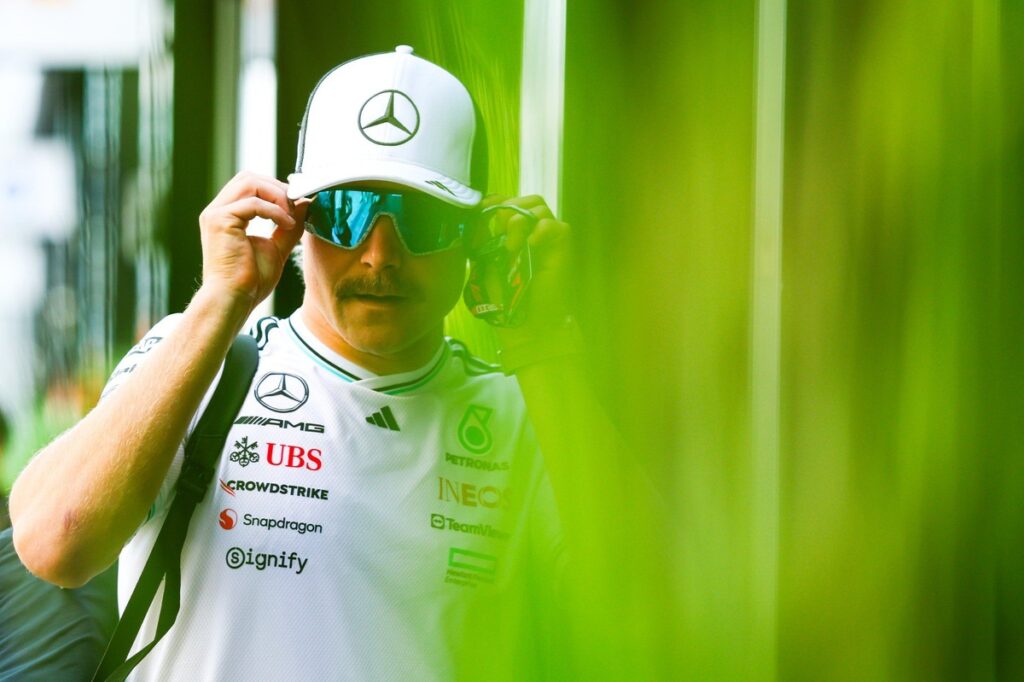As reported by Autosport in June, Valtteri Bottas is primed to agree terms with Cadillac to complete his return to a Formula 1 race seat. This leaves one much-coveted seat as the grid expands to 22 cars, and anyone without a contract next year has been linked to it.
Of them, Sergio Perez is considered the most likely and most attractive candidate to the team, given his experience and support from Mexico. From a geopolitical standpoint, an American team linking up with a Mexican driver feels somewhat incongruous, and F1’s bubble is not entirely impervious to global affairs, but you’d expect it not to be a factor here.
Otherwise, the likes of Zhou Guanyu, Mick Schumacher, Felipe Drugovich, Jack Doohan, Jak Crawford, and Paul Aron (plus others) have all had their names in the hat for Cadillac’s second seat.
If the team opts for a Bottas/Perez line-up, then it secures a combined total of 532 starts, 16 wins, and 3435 points. Since both drivers are 35, it’s not a long-term solution, but it’s a line-up that possesses great speed and a vast depth of knowledge. For the engineers, you’d know exactly where you are with them – and that data point is crucial for any team coming in from scratch. Think about all the things you don’t have as a start-up outfit: last year’s track data, a set-up repository, lived experience, and any of the other ephemera from the previous season.
Although the idea of Bottas and Perez making returns to the grid might be upsetting to those who wanted to see a fresh face (and fewer rump-themed calendars), it is an undoubtedly sensible pairing. And, should the talks with Perez go nowhere and the ex-Red Bull driver end up at Alpine (with whom he’s also understood to be in talks), then there’s still options with recent F1 experience.
Perhaps there’s something Cadillac can learn from how other all-new teams – not including buyouts – did it before it encourages anyone to put pen to paper. Is all-out experience the way, or is there something to be said for blooding a rookie driver at a low-pressure environment?
Haas in 2016: Grosjean and Gutierrez
Romain Grosjean, Haas VF-16
Photo by: Dirk Klynsmith / Motorsport Images
There was a real sheen of pragmatism in Haas’ 2016 entry to F1, and it reaped the rewards of that over its opening three seasons. Many asked questions about the depth of its links to Ferrari, with some contending that the team took more than the allowed, tradable ‘non-listed’ parts defined by the regulations. It had some Ferrari links on the driving front too, as Esteban Gutierrez was sprung from his Ferrari sim/reserve role to partner Romain Grosjean. The Franco-Swiss driver had, after a rocky start to life in F1, developed a reputation as a serious racer and represented something of a coup for the team.
Gutierrez, on the other hand, had two years of experience with Sauber but only one points-scoring finish to his name; still, a year working in Ferrari’s simulator was valuable knowledge in Haas’ hands. Indeed, the team stunned at the start of the year; although both cars were dumped out in Q1 in the first iteration of the unpopular elimination format, this mattered little as Haas went aggressive on strategy. Grosjean followed a one-stop strategy, taking his only pit call during the safety car brought out for Alonso’s clash with Gutierrez, and finished sixth as a result.
Haas went one better in Bahrain as Grosjean clinched fifth after starting an impressive ninth on the grid. On the other hand, Gutierrez scored no points in 2016 – and made way for Kevin Magnussen once the Dane had been jettisoned by Renault. Magnussen and Grosjean remained as the line-up for four years as Haas proved to be rookie-averse in its early years. After it later spent a year running with Mick Schumacher and Nikita Mazepin in 2021, it probably felt justified in that view.
Lotus in 2010: Kovalainen and Trulli
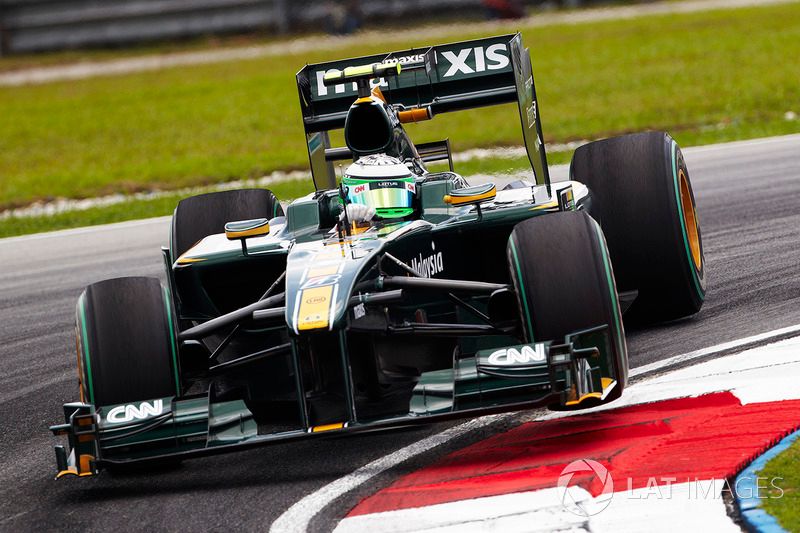
Heikki Kovalainen, Lotus T127
Photo by: Motorsport Images
An influx of three new teams in 2010 (initially four, before US F1 hit the wall) included a reimagining of Lotus, which boasted the financial firepower of AirAsia chairman Tony Fernandes and engineering experience of ex-Jordan/Renault/Toyota tech chief Mike Gascoyne. Although Lotus was accepted later than the other new teams, following news of BMW’s withdrawal in 2009, it arguably got the pick of the litter when it came to drafting its 2010 line-up.
Heikki Kovalainen was out of a drive when 2009 champion Jenson Button took his place at McLaren; the Finn had won the 2008 Hungarian Grand Prix, but had been little more than a number two to Lewis Hamilton in his two years in Woking. As Toyota withdrew late in 2009, Jarno Trulli’s services were acquired for the other car – he, too, had won an F1 race with Renault in 2004, and came with 13 seasons’ worth of battle-hardened F1 experience.
With a conservative T127 chassis, Lotus never truly challenged the points-scoring positions, although Kovalainen put the car in Q2 in a wet Malaysia race – fitting, given the team was registered under the Malaysian flag. Japan, however, presented the high-water mark: Kovalainen finished 12th and Trulli 13th to consolidate 10th in the constructors’ championship above fellow new entrants Virgin Racing and Hispania.
While the team retained its line-up for 2011, adding Renault power into the mix, Trulli was ousted on the eve of the 2012 season and replaced by Vitaly Petrov. Both drivers made way at the end of that year, the team having by now rebranded to Caterham, for the wealthier duo of Charles Pic and Giedo van der Garde.
Virgin in 2010: Di Grassi and Glock
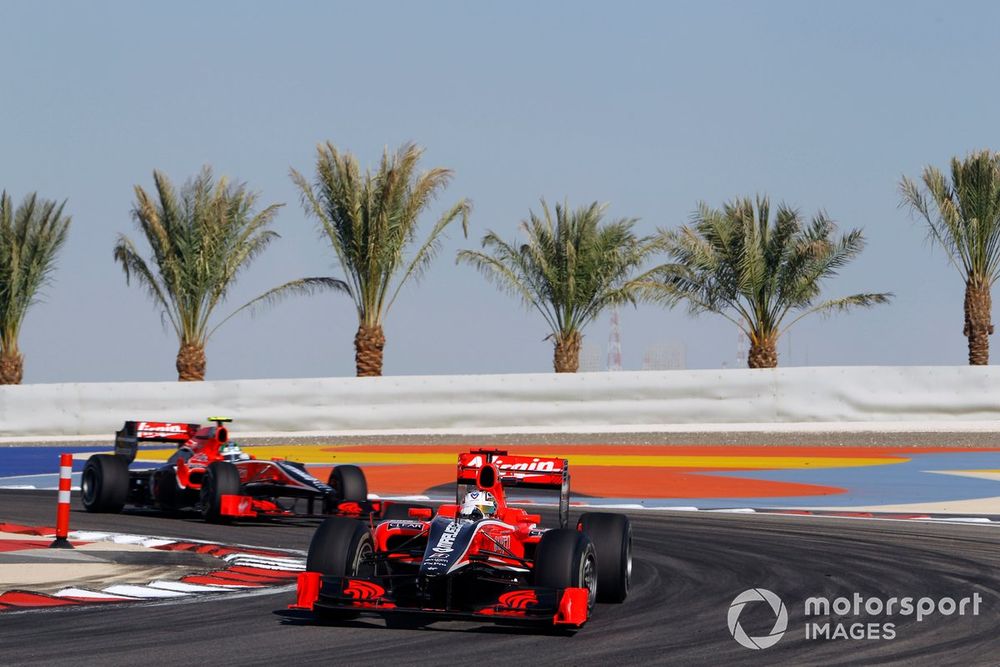
Timo Glock, Virgin VR-01 Cosworth, retired, leads Lucas di Grassi, Virgin VR-01 Cosworth, retired.
Photo by: Glenn Dunbar / Motorsport Images
Having intended to join F1 under the aegis of a cost cap, the deletion of the $40m spending limit scuppered the Manor-run team’s best efforts. The addition of Richard Branson’s Virgin Group as title sponsor had lent some degree of lustre, but the actual financial incentives were minimal; Virgin was apparently paying very little, and aiming to justify its place by pawning off livery space itself.
Technical chief Nick Wirth wanted to pioneer an all-CFD approach to the design of the team’s VR-01, which was certainly a way of spinning that it didn’t want to spend money on wind tunnel testing. What it had done, wisely, was secure the services of Toyota’s Timo Glock; the German had been ahead of Trulli in the points over 2009 before his Japan shunt, where the cracked vertebrae he’d sustained had put him out of action for the rest of the year.
Frequent GP2 frontrunner Lucas di Grassi joined as the team’s second driver; while a rookie to an F1 race seat, the loquacious Brazilian had run as part of Renault’s driver development programme and was known for possessing strong technical feedback. The team had issues, in that its aero package was underbaked and its fuel tank was too small to complete a race. Regardless, Glock was frequently a thorn in the side of the two Lotus drivers, although di Grassi was unable to match his team-mate over the year. Jerome d’Ambrosio later replaced di Grassi for the 2011 season, while Glock remained at the team for 2011 and 2012 as it developed into Marussia.
HRT in 2010: Senna, Chandhok, Yamamoto and Klien
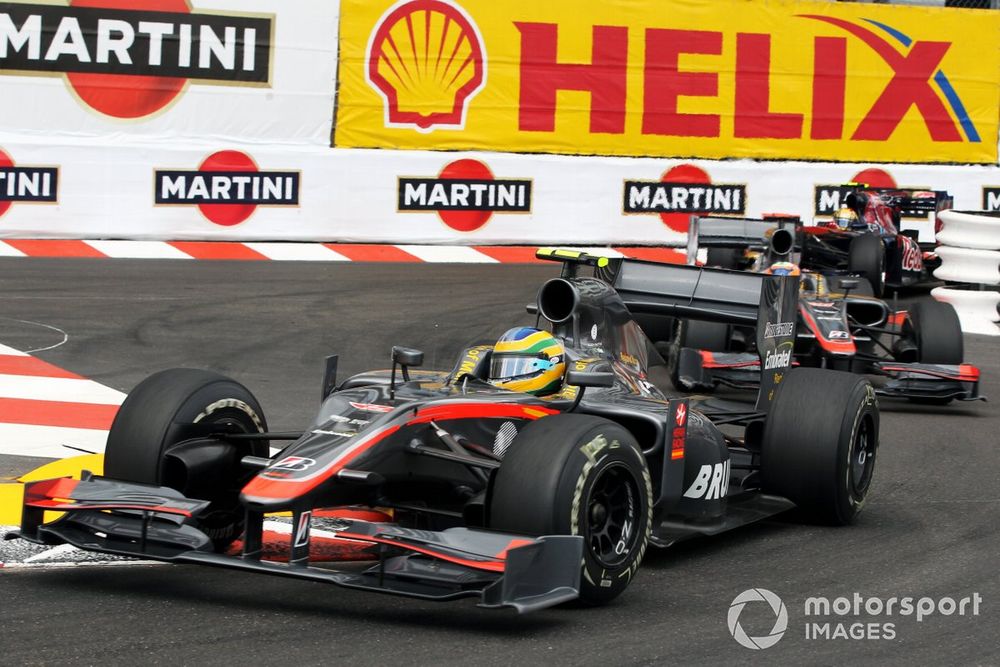
Bruno Senna leads Karun Chandhok
Photo by: James Moy
First it was Campos, then Hispania. The dribbling money tap caused the late Adrian Campos plenty of trouble in his team’s stilted preparation for its first year in F1, leading to its sale to Jose Ramon Carabante’s Grupo Hispania. To get the team off the ground, Hispania paid Dallara for the launch-spec model of its F110 (which remained undeveloped through the year, despite apparently promising update packages in the pipeline) and for Colin Kolles to run the team from his own Kodewa facilities in Germany.
To offset some of the costs, Hispania (or HRT, as it became more widely known) opted for two rookie drivers with finance available. Bruno Senna was in the frame for a Brawn seat in 2009, but ended up at the other end of the field with Hispania, and his old iSport GP2 team-mate Karun Chandhok found his way into the other car. Bar those advertising the Murcia tourist board, the rest of the stickers on the car came courtesy of the two drivers.
The car had not run until practice for the Bahrain Grand Prix, and Chandhok did not even turn a wheel until the start of qualifying – making it a minor miracle that he was ‘only’ 10 seconds off the pace of Fernando Alonso in Q1. While the two HRTs were off the pace, they weren’t that far off the Virgin cars – occasionally even outqualifying them.
To find some extra money in the second half of the year, Sakon Yamamoto was cycled into the driving line-up – firstly to replace Senna for Silverstone, then Chandhok for Germany and beyond. Yamamoto himself was then replaced by ex-Red Bull driver Christian Klien for Singapore, Brazil, and Abu Dhabi.
The team opted for an all-new line-up in 2011 of Force India cast-off Vitantonio Liuzzi and then raised eyebrows with the signing former Jordan driver Narain Karthikeyan – who had been out of F1 for six years at this point.
Super Aguri in 2006: Sato, Ide, Montagny and Yamamoto
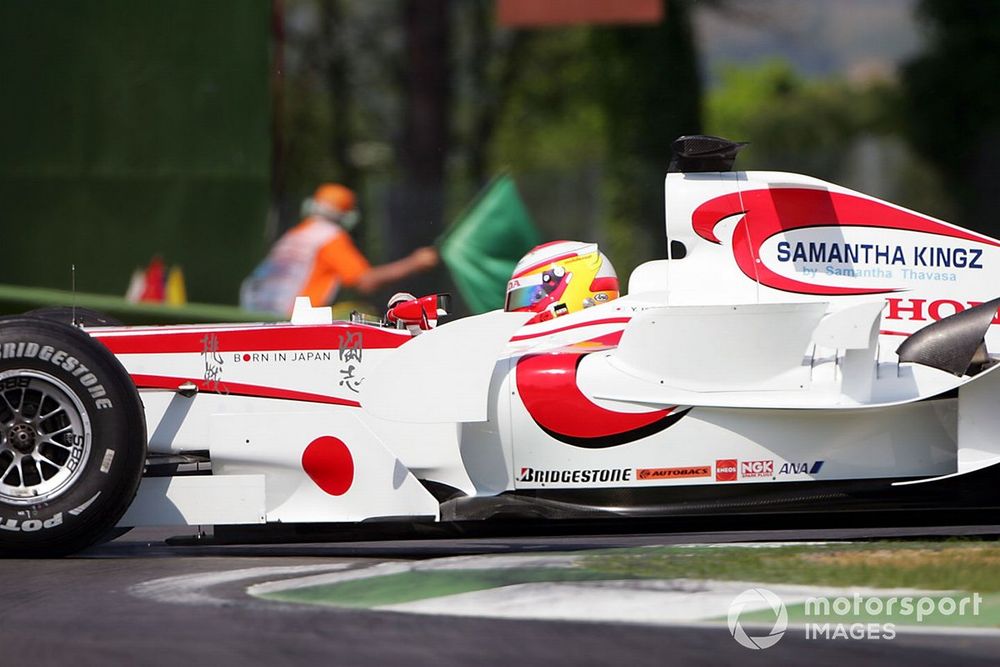
Yuji Ide, Super Aguri F1 SA05
Photo by: Mark Capilitan
Had Takuma Sato not found himself out of a Honda drive for 2006, then Super Aguri might not have come to pass. Aguri Suzuki’s team joined the F1 field late ahead of 2006, prompting the conversion of the Arrows A23 chassis from 2002 into a car that could feasibly work four years later. Sato was the centrepiece, as Honda wanted to keep the popular Japanese driver on board, but the second seat proved far more problematic – and not a particularly good for a rookie driver.
The team was linked with a handful of stars who had been successful in Formula Nippon, and it eventually settled on 31-year-old Yuji Ide, the runner-up of that year’s championship. Ide was woefully underprepared for his shot at F1, having never driven an F1 car and struggled with the language barrier with his predominantly English-speaking team.
In Bahrain, Sato was a second and a half off Midland’s Tiago Monteiro in qualifying, and Ide was almost another three seconds shy of his team-mate. While Sato attempted to close in on the established pack, despite the gulf in machinery, Ide was often miles behind. The San Marino Grand Prix was the kicker, however; Ide’s spectacular clash with Christijan Albers (who was tripped into a series of barrel rolls) became one of the reasons behind the FIA’s decision to withdraw the Japanese driver’s superlicence.
Long-time Renault reserve Franck Montagny drove for the next seven races, even outqualifying Sato in France, before Sakon Yamamoto came in to restore the all-Japan line-up in Germany, coincident with the introduction of its new SA06 car. Sensibly, Super Aguri partnered Sato with his former British F3 team-mate Anthony Davidson for 2007.
Toyota in 2002: Salo and McNish
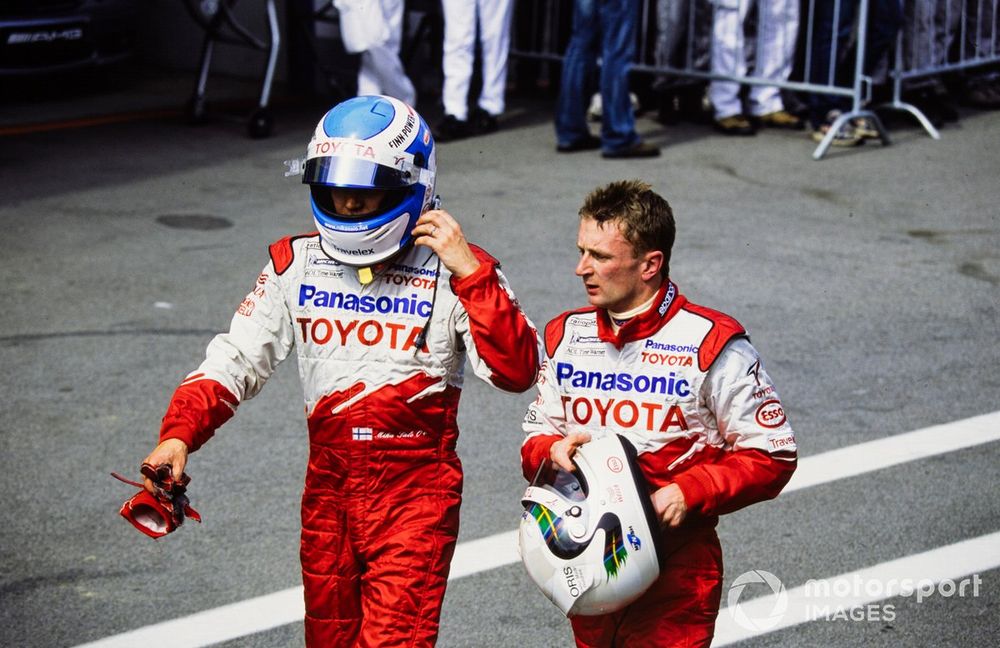
Mika Salo with Allan McNish, Toyota Racing
Photo by: Rainer W. Schlegelmilch / Motorsport Images
It’s forgotten that Toyota initially wanted to join F1 with a V12 engine, but the change in rules mandating the use of V10s set the brand back. Thus, it spent 2001 effectively following the F1 calendar with its TF101 test mule, a car that was good for little more than data collection. Rather than stay at Sauber for 2001, Mika Salo – almost a race winner with Ferrari – was lured to Toyota to spend a year testing, with a race seat for 2002.
Le Mans winner Allan McNish was also brought into the fold. The Scot had been on the fringes of F1 in the early 1990s, but had since switched to racing sportscars. He’d won the 1998 Le Mans 24 Hours in Porsche’s 911 GT1 car but, crucially, had previous with Toyota having driven its GT-ONE in 1999.
The 2002 season began well; Salo started the Melbourne season-opener in 14th and McNish 16th, although the latter was caught up in the opening-corner fracas precipitated by Rubens Barrichello and Ralf Schumacher. Salo picked his way through and finished sixth to pick up a point on the team’s debut. The Finn outqualified McNish 15-2 over the season; both drivers were frequently starters among the midfield, but found points hard to come by through the season.
McNish’s season was curtailed by a colossal crash in practice at Suzuka, but neither he nor Salo continued into 2003 – the team signed veteran Olivier Panis and IndyCar up-and-comer Cristiano da Matta in their places. Da Matta ensured that the car in front was a Toyota during that year’s British GP, but it was little more than a rarity in the Japanese manufacturer’s F1 tenure.
Stewart in 1997: Barrichello and Magnussen
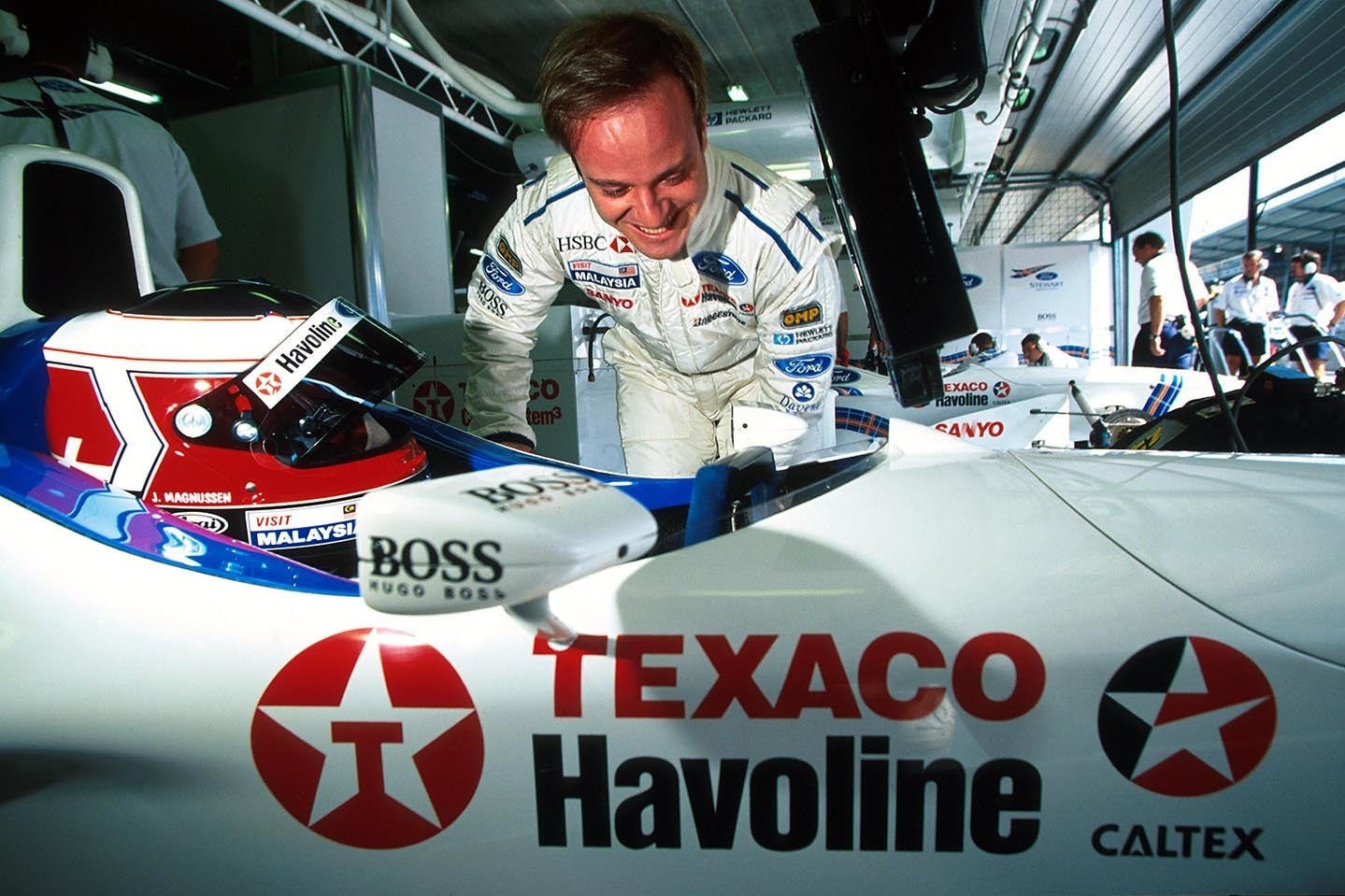
Jan Magnussen, Rubens Barrichello, Stewart Grand Prix Ford SF-1
Photo by: Sutton Images
At this point, Rubens Barrichello had been in Formula 1 for four seasons with Jordan. He’d been key part of the Silverstone squad’s growth in F1 but, when Jackie Stewart came calling, Barrichello took the gamble and threw his lot in with the team. After all, Stewart had assembled an impressive cast of sponsors and works Ford backing – and it ultimately proved to be his springboard into a Ferrari drive.
Joining him was Jan Magnussen, all but an F1 rookie aside from his single outing for McLaren in 1995 in place of a banned Mika Hakkinen. Magnussen came into F1 with huge potential, having dominated the 1994 British Formula 3 season driving for Paul Stewart Racing – so he was a known quantity to the team.
While Barrichello claimed the team’s headline result of 1997 with second at the Monaco Grand Prix, he did so amid terrible unreliability; Stewart could comfortably qualify well and Ford’s V10 was powerful, but had a frequent habit of self-immolating. Even so, the Brazilian was regularly putting his SF01 in the top half of the grid – Magnussen was not able to match his more experienced team-mate.
It’s said that Stewart offered Magnussen driving lessons, something that didn’t necessarily go down well with the Dane. The team retained its line-up for 1998 but, just as Magnussen scored his first point in F1, he was replaced by another “dad of” in Jos Verstappen.
Lola in 1997: Sospiri and Rosset
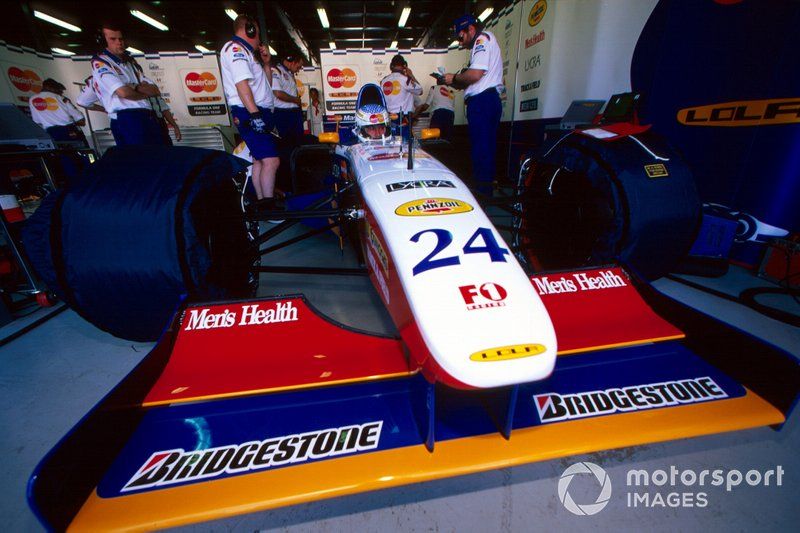
Sospiri got a long-awaited F1 call-up with Lola, but the team was a disaster
Photo by: Sutton Images
If we’re covering Stewart, let’s do the beleaguered Lola outfit too. Amid all of the hare-brained technical ideas perpetuated by Eric Broadley that were scarcely up to F1 standard, and its financing plan that subsequently produced… well, little finance, Lola’s driver line-up was arguably the least of its worries. Much to the delight of environmentalists everywhere, Ricardo Rosset had pulled up no trees in his debut season with Arrows, but at least brought cash into the team.
His team-mate, former Super Nova F3000 stablemate Vincenzo Sospiri, had often been considered as a future F1 driver but with no real opportunities to do so aside from testing outings for Benetton.
As it happened, the T97/30 was so slow and cumbersome in the Melbourne practice sessions that it mattered little who drove it, although Sospiri at least dragged a 1m40.972s out of it in qualifying – 1.1s faster than Rosset. The problem was that this was 11.6s slower than polesitter Jacques Villeneuve, putting it way outside of the 107% time needed to qualify. The team arrived in Brazil for round two, but was immediately shuttered thanks to the debts it had accrued.
In this article
Be the first to know and subscribe for real-time news email updates on these topics
Read the full article here

